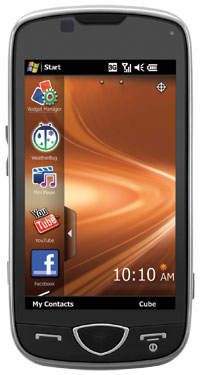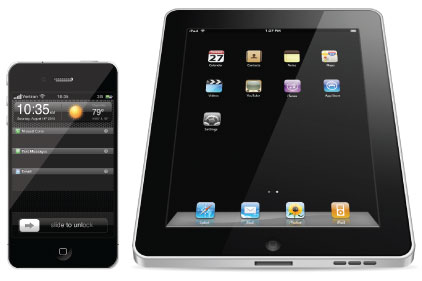
|
Like it or not, we’re all connected, all the time. From cellphones to smart phones, tablets, iPads, “i-everything” – we are all mobile to one extent or another. Whether bound to a desk or constantly on the road, it’s convenient to use mobile devices to do work, while at work.
Being connected, being mobile, may be the “new normal,” says a CDW Government report, which found that more than half of Federal employees use at least one mobile device at work, and many are using personal devices to accomplish work-related tasks. Nearly all Federal employees who use a mobile device for work believe the device makes them more productive, and the majority say increased mobility will improve citizen service.
The report found that mobility is no longer just a nice-to-have capability: 99 percent of those surveyed said they have deployed mobile devices to their agency workforce. What’s more, 62 percent of those IT professionals said their agencies allow employees to use personal devices for work.
Video on the I…the Pad or Phone
Of course, remote access to video and being mobile is not new. For many years, security directors have used a computer connected to a cable modem, for example, to view images. But viewing video on a smartphone or iPad?
It’s already here. For example, patrol officers in 24 Montgomery County, Ohio localities have comprehensive crime information in real time that could help them protect residents better. The system is JusticeWeb, and it currently serves 240 local, state and federal agencies in Ohio and Indiana. It has been especially helpful as the police department shrunk from around 380 officers last year to around 330 to start this year.
JusticeWeb – with upgrades funded through $144,000 federal grant – tracks incarcerations, warrants, dispatches, traffic stops, calls for assistance, arrests, field interrogations and other information. So when an officer makes a traffic stop in downtown Dayton, he/she can check all the driver’s interactions with police throughout the county as far back as 10 years.
All that is needed for an officer to access the enhanced website is a WiFi connection – or better yet – a smartphone. The city is toying with the idea of getting tablet computers for officers to fully utilize the new capabilities.
Seve Padilla is using his iPhone for video surveillance, as well. Padilla is director of security for Falls Church (Va.) City Schools. When Padilla upgraded the school’s access control system, he installed RedCloud Virtual, a web-based integrated access control system. “The old system relied on the software client to be installed onto individual computers in order to access it,” Padilla says. “This made it extremely difficult to maintain, given that we are constantly upgrading our machines. The new system is Web-based via our secure network server. As long as I’m on the network, either our wireless system or via a network cable, I can access the software from any machine within our school division. Additionally, via our wireless network within the buildings, I can access the system from my iPhone or iPad. When not in range of our wireless network, I am able to access the system from my home computer, iPhone or iPad by simply logging into my VPN client, which then accesses my secure network.
All-in-all, the RedCloud system has altered the way we operate our facilities from a security standpoint,” Padilla explains. “It gives us unlimited accessibility. From a maintenance standpoint, I’m now able to trouble shoot a card reader error by simply pulling out my iPhone rather than altering my schedule by going back to my office.”
Jon Brady is also using his iPad to view video. Brady is the safety and security director with the North Kansas City School District, which has 18,000 students – 21 elementary schools, five middle schools and four high schools. Thanks to American Digital Security, an exacqVision integrator in Liberty, MO, the company has developed a mobile platform for the exacqVision IP video surveillance software and Axis IP cameras.
In the North Kansas City School District, each school administrator has an iPad that can be used to call up video, in real time. “I can pull up the video and employ resources, if needed, and adjust my manpower,” says Brady. “It helps me to more efficiently and effectively handle schedules. We like it because we are not tied to our desktop or laptop to access the camera systems. The iPad is easier to carry than a laptop.”
In another example, law enforcement officers from the Alabama Department of Natural Resources, Marine Resources Division are using smart phones to view camera images/video from cameras stationed around Mobile Bay, Ala.
The Coastal Remote Monitoring System enables Marine Resources Division officers to remotely view video and still images and control pan, tilt, zoom functions, using a smart phone or laptop computer, to investigate potential security risks round-the-clock.
Security executives may be even more mobile in the future, thanks to Apple, which recently announced that it is working on new technology with possible applications in gaming, photography and surveillance, to mention but a few, according to the web site PatentlyApple.
Apple has reportedly filed a patent relating to a 3D eye-tracking based interface with the US Patent & Trademark Office. Applications range from high-end security features, such as biometric and surveillance functions, to entertainment applications such as gaming, as well as photography and video recording tools that could be derived from this patent. This new technology could enhance the experience for not only iPhone and iPad users but also possibly be integrated into Macs.
Security Implications
While accessing security video from your iPad is shiny, new and fun, there are security implications. According to a Juniper Networks report, “Security Best Practices for the Mobile Enterprise,” the biggest challenge related to mobility is how to accommodate all of the different users, many of whom have multiple devices running a variety of different applications, as they connect to the enterprise network in different ways, at different times and from different locations. Some of the devices will be secured with up-to-date antivirus software, but because many devices are personally owned, a growing number will not be secure, the report notes.
What changes will needed in an enterprise's security operations?
“While there are many such issues, the focus is on security and the impact is equally profound,” the report says. “If not properly handled, the use of personal devices presents a serious security threat. Most of these devices will lack robust security provisions such as antivirus and personal firewall protection. Many will contain hundreds of apps, including downloaded music and video files, games, and other software. Many will access social networking sites. Some users will even have multiple devices and will want to synch their personal data (including their calendar and contacts) among, for example, the corporate issued laptop and the personal tablet and smartphone.”
Of all the mobile devices, laptops are the easiest to secure, and smartphones are the most challenging, with tablets falling somewhere in between, the report says. The solution? Purpose-built mobile security applications that includes personal firewall, anti-malware, and spam filtering, and that should also support critical mobile device management capabilities such as remote wiping or deletion of sensitive data for lost or stolen mobile devices, the report suggests.
| 5 Tips about Mobile Video Surveillance Apps |
|
1. Mobile apps typically are paired with one or more specific DVR models from specific manufacturers. In selecting a DVR, dealers should consider the capabilities of the app as well as the DVR, even if they don’t initially expect a customer to use the app.
2. Consider a mobile app/DVR combination that gives mobile users the ability to adjust compression or resolution. As Jorg Tilkin, product line manager for Xtralis notes, even relatively low-resolution images look good on a small screen. And the less bandwidth is used for image display, the more quickly images can be refreshed — an important consideration when running over mobile networks, which may have less bandwidth than a landline connection.
3. Some mobile app stores give end users the opportunity to rate an app by, for example, assigning a specific number of stars to the app. These ratings can be useful in selecting which app to use — and in touting the benefits of your chosen app to potential customers.
4. Mobile apps can be useful for a dealer’s technicians during the installation of a video surveillance system, notes Mike Hendrix, tech support team leader for Industry, Calif.-based Hikvision, a manufacturer that offers mobile apps that work with its DVRs. Technicians can remove the DVR’s address from the app when the installation is complete.
5. If you are using an NVR, rather than a DVR, consider using a separate server to support mobile users. This approach may entail a one-time license fee, but should enhance the app’s performance, notes ClearPix Technology’s Buddy Mason.
Information provided by Joan Engebretson, contributing writer for SDMMagazine. Read more at: http://www.sdmmag.com/articles/mobile-apps-bring-sizzle-to-surveillance |




